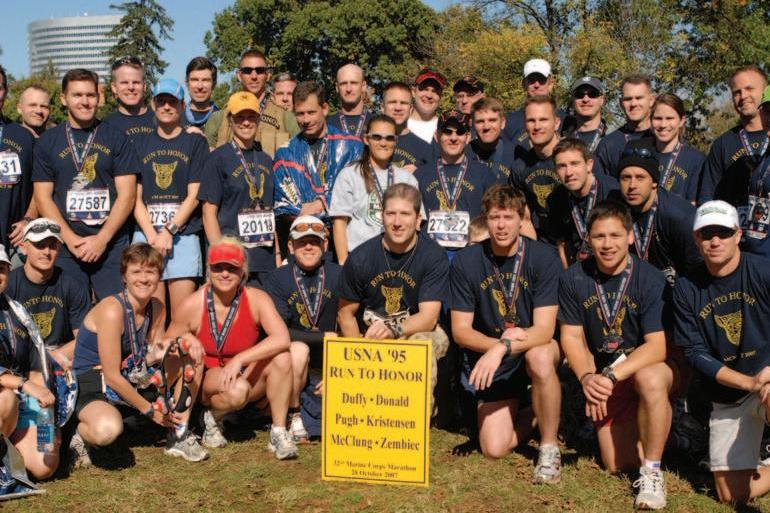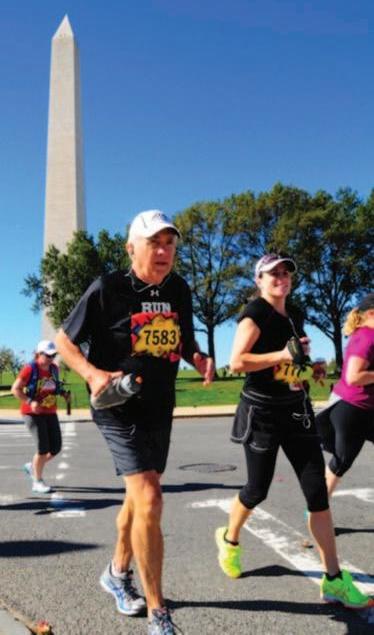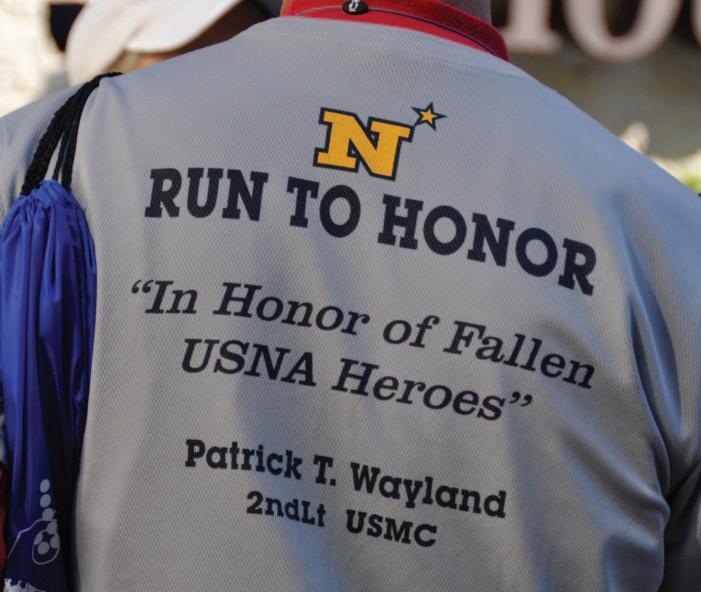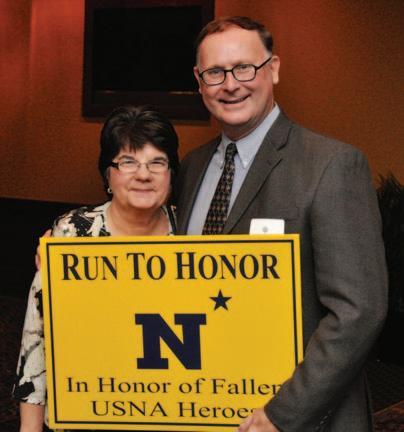
9 minute read
The alumni community is preserving stories of honor and valor
WE WILL NEVER FORGET
In December 1944, Captain Francis Bridget, USN, Class of 1921, boarded ORYOKU MARU to be transported to Japan after being held as a POW in the Philippine Islands. The ship was sunk by American planes at Subic Bay and the survivors were boarded onto ENOURA MARU. While docked in Taiwan, the second ship was also bombed by American planes and many on board were killed.
Bridget survived, but succumbed to his injuries while on board BRAZIL MARU before it reached Japan on 29 January 1945.
Throughout the chaos and uncertainty, Bridget maintained command over the 800 American POWs packed into the ship’s holds. He repeatedly risked his life attempting to negotiate with his captors. For his efforts, he was awarded a posthumous Legion of Merit.
Bridget’s story is one of sacrifice and valor—and one that might have been lost to time if not for the efforts of Run to Honor, a group of Naval Academy alumni dedicated to preserving the legacies of all fallen shipmates.
Honoring Shipmates
Run to Honor has its roots in the Class of 1995 after three classmates were killed in action in the span of two years in the Global War on Terrorism—Lieutenant Commander Erik S. Kristensen ’95, USN; Major Megan M. McClung ’95, USMC; and Major Doug A. Zembiec ’95, USMC.
Richardson and Jeffrey R. Webb ’95 were processing their grief when they separately arrived at an idea to gather a group of alumni and run the Marine Corps Marathon in honor of their fallen classmates. They each approached their class president with the proposal, who then connected them. Along with Lieutenant Commander Giovanna Kostrubala Meek ’95, USNR, they formed a committee to organize the run.
Their goal was simple: get 95 people to run the marathon or the 10K in honor of the Class of ’95.
“It exploded,” Richardson said. “We ended up having several hundred people participate that weekend. And we
The Class of 1995 pays tribute to the fallen members of their class in a 2007 Run to Honor event.

Col Justin Wickens ’60, USMC (Ret.), participated in the 2014 Marine Corps Marathon.
Photo courtesy of Pat McConnell had hundreds of supporters there and signs all over the course.”
With the added interest, the committee decided to host a dinner at Navy-Marine Corps Memorial Stadium the night before the race to motivate runners and show support to the families of the deceased. Colonel John Ripley ’62, USMC (Ret.), known for his extraordinary service in Vietnam, was a mentor to Zembiec and guest speaker at the dinner. Special guests included former Superintendent Rear Admiral Tom Lynch ’64, USN (Ret.); former Commandant of Midshipmen Captain Randy Bogle ’68, USN (Ret.); and former Deputy Commandant of Midshipmen Major General Charles Bolden ’68, USMC (Ret.).
The dinner also included a tribute to Zembiec, McClung and Kristensen, as well as three other classmates—Lieutenant Brendan J. Duffy ’95, USN; Lieutenant Bruce J. Donald ’95, USN; and Lieutenant Richard S. Pugh ’95, USN—who were killed in military operations between 1996 and 2001.
Dave Paddock ’77 was a member of the Naval Academy Alumni Association Board of Trustees when he was invited to participate in the 10K race. He recalls the emotion in the crowd as McClung’s father presented the Penguin Award—which McClung created during the 2006 MCM Forward in Iraq—to the last place marathon finisher.
“It just hit home how real it is,” said Paddock, who serves as president of Run to Honor. “It affected me, and I wanted to participate in this organization. In October of 1983, I had a classmate I didn’t know, Captain Michael J. Ohler ’77, USMC, who was killed by a sniper in Beirut. And then the next week, I’m watching the news and I see the name of two of my friends, Captain Vincent L. Smith ’76, USMC, and Lieutenant James F. Surch ’77, USN, who were killed in a bombing.
Webb and Richardson were also inspired by McClung’s father that day. After the race, McClung approached them about the success of the event and closed by saying, “See you next year.”
Surprised, Webb and Richardson turned to each other. They had gone into the weekend thinking it was a singular event, but both agreed they had stumbled upon something special. The organizers soon decided to make Run to Honor an annual event and honor every graduate on the walls in Memorial Hall—and their families.
“It’s not only doing all we can to tell the stories of the heroes that represent the best of the Naval Academy,” Richardson said. “It’s about supporting their families that are left behind. I’ve learned that that grief will never go away for them. As an organization, we have been able to do all that we can to, as a Naval Academy family, put our arms around them and let them know that we’re here for them in small ways and big.”
Over the years, the dinner continued to expand, while the Naval Academy Alumni Association launched its own efforts to honor alumni killed in

The Run to Honor Shared Interest Group is dedicated to preserving the legacies of all fallen shipmates. Participants often wear shirts, like this one from a 2014 event, emblazoned with the name of a loved one or friend.
WE WILL NEVER FORGET
combat and during military operations. At first, the two organizations held overlapping events during the same weekend. Now, the Alumni Association hosts Honor Our Fallen Heroes, a weekend-long event, as well as on-field recognition of fallen classmates and their families during a football game.
Run to Honor, meanwhile, has evolved into a Shared Interest Group within the Association and offers its support for the weekend’s events. Together, they’re planning the next weekend, which will be held on 11 September 2021 and will commemorate the 20th anniversary of the attacks and the alumni lost during the subsequent Global War on Terrorism.
“[The Alumni Aassociation] is truly institutionalizing how we are honoring and remembering our fallen shipmates, and Honor our Fallen Heroes is the most visible aspect of that,” Webb said. “Run to Honor is like a startup that can move quickly and do what we want. They have a platform to bring together family members and to get the word out. There’s a place for both of these in the work that we’re doing, and we’ve collaborated well.”
In 2015, Richardson received an email from Deanna Matzko Stash whose father, Major Dean Matzko ’66, USMC, died in 1979. She was up late one night, searching the internet for information about her father, when she stumbled across his name on the Run to Honor website in a program from the most recent dinner.
Matzko and Richardson began corresponding. They traded stories about her father, a Vietnam veteran and pilot, and her brother, a Naval Academy graduate stationed in Maryland. Richardson responded by telling her about the purpose of Run to Honor and she attended the next dinner.
Soon after, an idea began to take shape among the members of Run to Honor. What if they could tell the stories behind every name in Memorial Hall?
The board approached Pat McConnell ’02, a computer science major who built a website for his class. They started with the list of names and McConnell began searching for any details he could find.
Four million words later, the Virtual Memorial Hall (https://usnamemorialhall.org) is a digital record of the more than 2,700 names etched into the walls of the physical Memorial Hall.
This includes alumni from the Class of 1846 to the present. Most records have at least their cause of death and a Lucky Bag entry, as well as awards and commendations. McConnell and two other researchers take one name at a time, scouring the internet, the Navy directory and officer register, Naval publications and genealogical history sites.
The personal stories come in from family members, friends and classmates. Some stumble across the site, or a post on Facebook. There’s often an increase in submissions around Memorial Day. McConnell is eager to capture these stories.
“I’ve got a lot of data, like, in 1904 they were stationed at this ship,” McConnell said. “What I’m more interested in is trying to find testimonials of them—he was a strait-laced officer, or he was a joker or everyone loved the guy. We’re trying to put some life behind the names.
“Memorial Hall is an amazing place, but it’s also pretty cold. It’s a lot of granite, a lot of open space—and that’s perfect for what it is. But the benefit of a website is I can put every picture I come across, and make those linkages between other people in Memorial Hall, try to do our best to flesh these men and women out as people and not just a name or a statistic.”
The website has become a destination for researchers. Last year, 128,000 visitors came to the site. They land on the site while researching a distant relative from generations past, or wondering what happened to a classmate from high school who served in Vietnam.
Some of those visitors include the Naval Academy’s newest midshipmen. Thanks to a new program called First Link, every plebe is assigned a unique name in Memorial Hall. They’re responsible for knowing the person’s story and many plebes start their research in the Virtual Memorial Hall.
“As a current member of the faculty, it’s special to see the stories of these heroes live on,” Richardson said. “Knowing some of them personally, it’s hard not to get choked up when Doug [Zembiec] is the focus of a Brigade honor discussion or the plebes run by Erik [Kristensen]’s grave at Hospital Point and stop to learn about leadership. The valor and sacrifice of the Academy’s finest truly resonates and inspires the next generation.”
Whether it’s recognition at a football game, or Marine Corps Marathon and Memorial Day runs, or an entry on a website, those remembrances—and supporting the families left behind— are the undercurrent of everything Run to Honor does.
“It’s hard to conceptualize that feeling of loss until it happens to you,” Paddock said. “You feel it in an enduring way, even if you didn’t know that person; if he or she was a classmate or shipmate, you feel it. And you know, but for the grace of God, it could have been you.
“So, each class has a responsibility to keep their classmates’ memories alive and stay connected to the families as long as they wish to be contacted.” a

CAPT Ralph E. Janikowsky ’77, USN (Ret.), and his wife, Linda, attended the 2015 Run to Honor ceremony.





